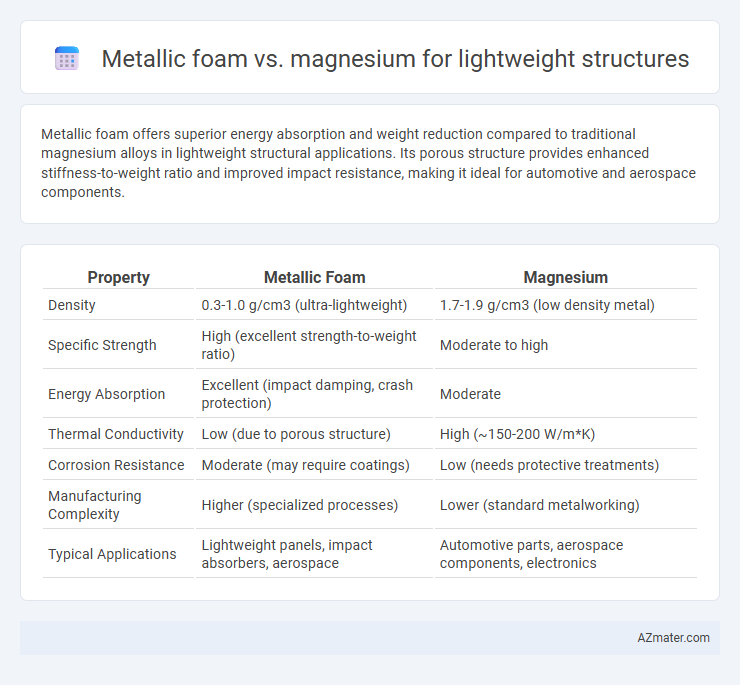Metallic foam offers superior energy absorption and weight reduction compared to traditional magnesium alloys in lightweight structural applications. Its porous structure provides enhanced stiffness-to-weight ratio and improved impact resistance, making it ideal for automotive and aerospace components.
Table of Comparison
| Property | Metallic Foam | Magnesium |
|---|---|---|
| Density | 0.3-1.0 g/cm3 (ultra-lightweight) | 1.7-1.9 g/cm3 (low density metal) |
| Specific Strength | High (excellent strength-to-weight ratio) | Moderate to high |
| Energy Absorption | Excellent (impact damping, crash protection) | Moderate |
| Thermal Conductivity | Low (due to porous structure) | High (~150-200 W/m*K) |
| Corrosion Resistance | Moderate (may require coatings) | Low (needs protective treatments) |
| Manufacturing Complexity | Higher (specialized processes) | Lower (standard metalworking) |
| Typical Applications | Lightweight panels, impact absorbers, aerospace | Automotive parts, aerospace components, electronics |
Introduction to Lightweight Structural Materials
Metallic foam offers exceptional strength-to-weight ratios and energy absorption, making it ideal for lightweight structural applications where impact resistance is crucial. Magnesium, being the lightest structural metal, provides high specific strength and excellent machinability but typically lacks the energy absorption capabilities of metallic foams. Selection between metallic foam and magnesium depends on balancing weight reduction with mechanical performance and application-specific durability requirements.
Overview of Metallic Foams
Metallic foams are lightweight, porous materials characterized by a high strength-to-weight ratio and excellent energy absorption capacity, making them ideal for lightweight structural applications. Unlike solid magnesium, metallic foams combine low density with enhanced stiffness and improved thermal and acoustic insulation properties. These materials are widely used in automotive and aerospace industries to reduce weight while maintaining structural integrity and safety.
Properties of Magnesium Alloys
Magnesium alloys exhibit exceptional strength-to-weight ratios, making them ideal candidates for lightweight structural applications where reducing mass is crucial. Compared to metallic foams, magnesium alloys offer superior mechanical properties such as higher tensile strength, better impact resistance, and improved fatigue performance. Their excellent corrosion resistance and ease of fabrication further enhance their suitability in automotive and aerospace industries focused on weight reduction and structural integrity.
Weight Reduction Strategies in Engineering
Metallic foams exhibit significantly lower density compared to solid magnesium, offering exceptional weight reduction through their porous architecture, which enhances energy absorption and impact resistance in lightweight structures. Magnesium alloys provide high strength-to-weight ratios and excellent machinability, but metallic foams surpass them in reducing overall structural mass while maintaining mechanical integrity. Weight reduction strategies in engineering increasingly leverage metallic foam composites for applications requiring optimized stiffness-to-weight ratios and crashworthiness, outperforming traditional magnesium components.
Strength-to-Weight Ratio Comparison
Metallic foam exhibits a superior strength-to-weight ratio compared to conventional magnesium alloys, offering enhanced energy absorption and impact resistance while maintaining significantly lower density. Magnesium's higher tensile strength is offset by its greater weight, making metallic foam more advantageous for applications requiring lightweight structures with optimized mechanical performance. The cellular architecture of metallic foam enables a balance of stiffness and strength, outperforming solid magnesium in weight-sensitive engineering designs.
Impact Resistance and Energy Absorption
Metallic foam outperforms magnesium in impact resistance due to its cellular structure, which dissipates energy more effectively under sudden loads. Its high porosity enables superior energy absorption, making it ideal for lightweight structures requiring crashworthiness and vibration damping. Magnesium offers lower density but less efficient energy absorption and impact resistance compared to metallic foam composites.
Corrosion Resistance and Durability
Metallic foam offers superior corrosion resistance due to its porous structure and protective oxide layer, making it highly durable in harsh environments compared to magnesium, which is prone to rapid corrosion unless treated. Magnesium alloys provide exceptional lightweight benefits and good mechanical strength but require coatings or alloying elements to enhance their corrosion resistance and long-term durability. For lightweight structural applications demanding extended lifespan and resistance to environmental degradation, metallic foam demonstrates a more robust performance profile.
Manufacturing Techniques and Scalability
Metallic foam manufacturing techniques such as powder metallurgy, foaming of molten metal, and infiltration casting offer scalability for lightweight structural applications but often involve complex processing and higher costs compared to magnesium alloys. Magnesium, processed primarily by die casting, extrusion, and rolling, provides established large-scale manufacturing with excellent machinability and lower weight-to-strength ratio. Scalability of metallic foams is limited by foaming control and defect management, whereas magnesium benefits from mature supply chains and cost-effective production for automotive and aerospace lightweight components.
Cost Analysis and Sustainability
Metallic foam offers superior lightweight properties and energy absorption at a higher material cost compared to magnesium, which is generally more affordable but less efficient in impact resistance. Magnesium's recyclability contributes to lower environmental impact, while metallic foam's production involves complex processes that increase energy consumption and cost. Considering lifecycle costs, magnesium presents a more sustainable option for lightweight structures when balancing initial expenses and long-term environmental benefits.
Future Trends in Lightweight Structures
Metallic foam offers exceptional energy absorption and high strength-to-weight ratio, making it a promising material for future lightweight structural applications compared to traditional magnesium alloys. Advances in additive manufacturing and nanostructuring are enhancing the mechanical properties and durability of metallic foams, enabling their integration in automotive and aerospace sectors. Ongoing research emphasizes sustainability and recyclability, positioning metallic foam as a key component in next-generation lightweight structures focusing on performance and environmental impact.

Infographic: Metallic foam vs Magnesium for Lightweight structure
 azmater.com
azmater.com